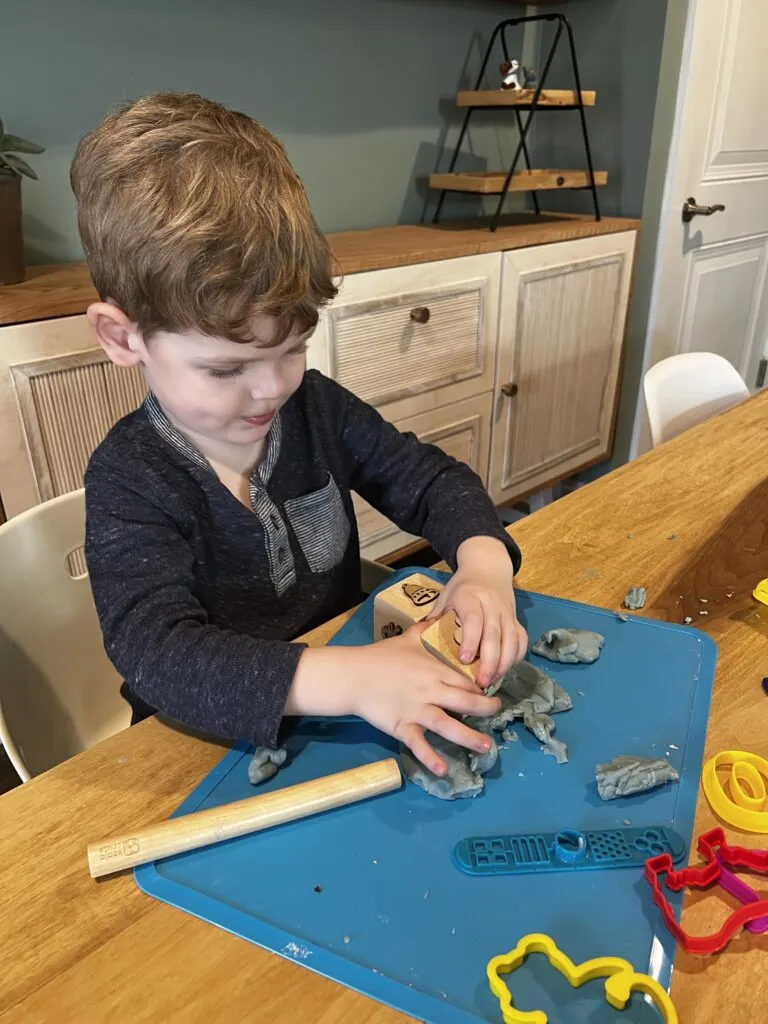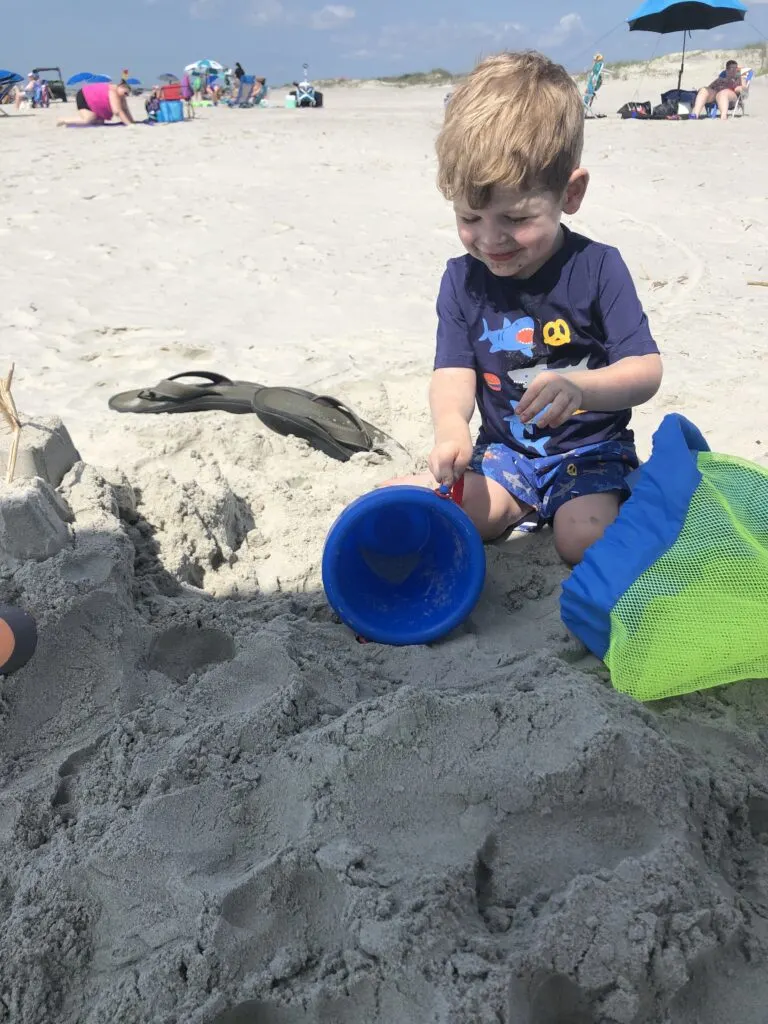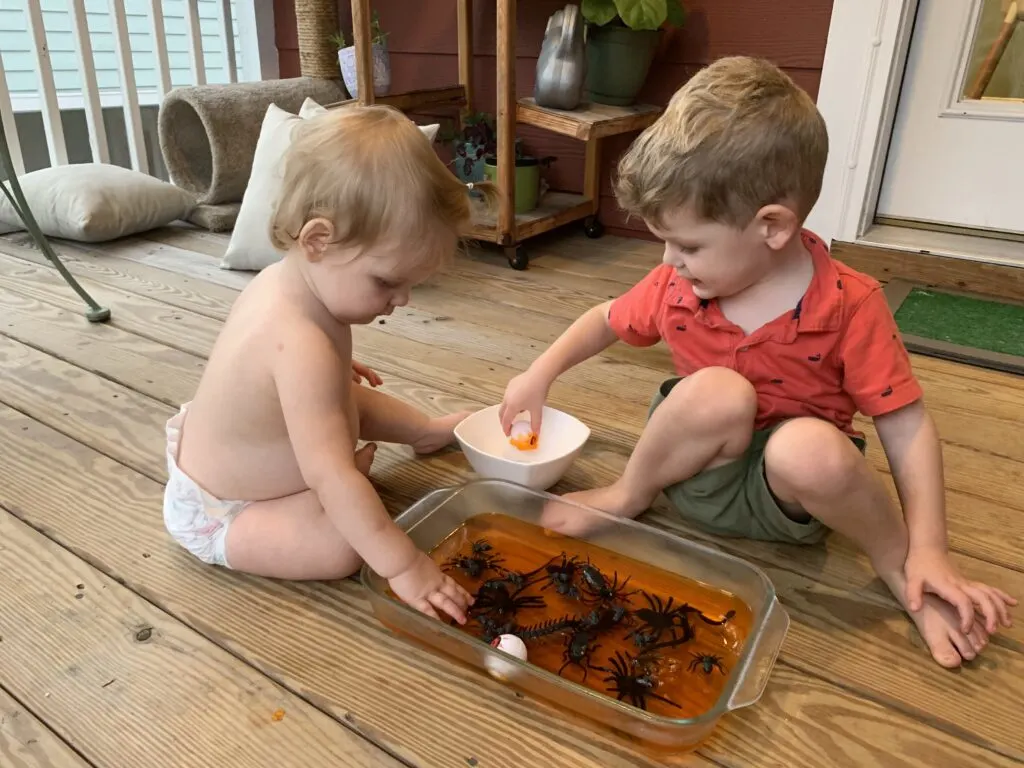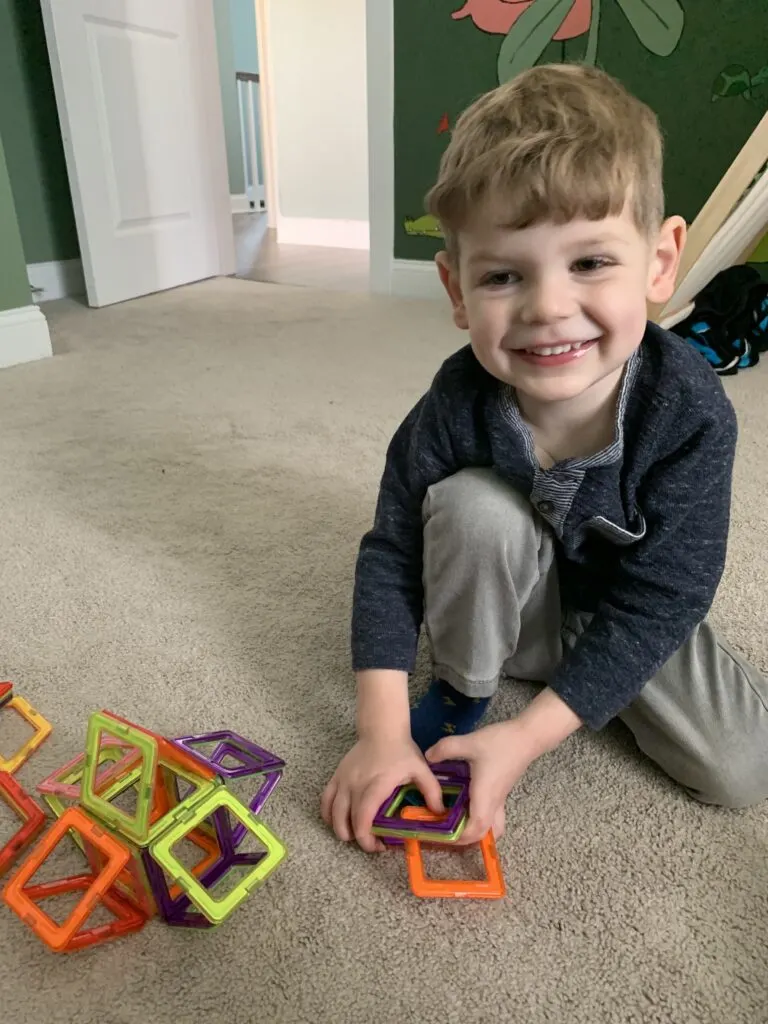Do you wish that your kids would play more independently? Here are my best tips on how to encourage independent play in kids!
As work-from-home parents to a 1.5 year old and a 3.5 year old, it’s important for everyone’s sanity that our kids learn to play independently!
I have learned that there is no guilt in letting your kids play by themselves – as long as you do it the right way.

What is independent play?
It is super important that your kids be able to play independently.
Independent play is a lifelong skill. Let’s face it – they are going to be bored and alone a good amount of their life. It is crucial that they practice being alone and entertaining themselves.
Independent playtime promotes imagination and creativity. It teaches problem solving and the important skill of sitting alone with yourself and your own thoughts.
Independent playtime should be self-sufficient, unassisted, free time. This is a time when kids are on their own, doing their own thing, and making choices about what they are doing.
Independent play does not mean ignoring your children. It means providing them the means to play by themselves in a planned and protected manner.
Independent play vs quiet time
Around the age of 3, many kids stop napping. In lieu of napping, it’s appropriate to ask them to have quiet time in their rooms. This Quiet Time is a time for independent play, but not all independent play has to be during quiet time.
Independent play time could include times when their adult is:
- Folding laundry
- Cooking a meal
- Washing dishes
- Making a grocery list
- Feeding a baby sibling
- Working on the computer
- Riding the exercise bike
- Reading a book
- Taking a shower
Having successful independent play time is an essential skill for your kids, but it is also important for their caregivers.
Whether you are a stay at home parent, work from home parent, caregiver, or something in between, you cannot devote every second of the day to your kid. And you shouldn’t have to! Having an established independent play routine is great for everyone and prepares your child for the future!

A few guidelines
I don’t like rules (I am more of an “ask forgiveness, not permission” kind of person!) but it is good to have guidelines around independent play.
Childproof the space
Be sure that the area where you are leaving your kids – especially if you are leaving them alone in a room – is completely safe. Anchor furniture to the walls. Remove anything fragile. Use your judgment as to how close you need to be to your child, if you need to be in the room or if you can use a monitor to watch them.
Cut down the clutter
I bet you have a lot of toys. Believe me – we have 2 playrooms, 2 kids bedrooms, and a big shelf of toys in our living room. But, for independent play time, having too many options is overwhelming.
Pull out one to three toys or workbooks for your child (depending on how long you expect them to play) and put everything else away to keep them from getting overwhelmed.
Keep it screen free
I am not anti-screen by any means. But, watching TV is not independent play. Playing a game on your phone isn’t either.
There is a time and place for everything, but try to keep screens out of the independent play routine, or they will become a necessity!
Don’t intervene
If you are in the same room as your child, try to leave them alone. If your toddler is stacking blocks for example, don’t tell them what a great, tall tower they built.
That’s fine for together time, but for independent time, try to stay out of it. Once you pipe in, it’s hard for them to bounce back to playing alone!
Praise them
Especially when kids are starting out playing independently, praising them goes a long way. Let them know what a great job they did and what a big kid they are becoming! Preschoolers love being called big kids and really respond well to that specific praise.

Independent Play by age
Independent play looks different for kids of different ages.
Baby
Babies can play independently! I know, it sounds ridiculous, but it is true. The easiest way that most babies play independently is on a play mat. Choose a flat surface where they are safe and lay out a quilt or blanket.
Place the baby on their back or on their tummy and give them something to look at. Maybe it is a mobile or a play gym. Maybe it’s a few toys. They love toys that roll, light up, crinkle, or jingle.
Of course, you will want to stay nearby and keep them in sight. I used to lay a play mat in the laundry room while I folded laundry or put my infant in an activity center in the bathroom while I took a shower.
These are all examples of small amounts of supervised independent play and a great way to get your child in the habit of playing independently from a young age.
Toddler
Toddlers are actually a bit trickier than babies to get to play independently, in my experience! The easiest time to let a toddler play independently is in their crib after waking up from a nap.
If they are not screaming and are safe, let them hang out for a few minutes. Once it is developmentally appropriate, put a toy in their crib with them for them to wake up with. This will help them learn that they are OK on their own in a safe environment.
When they get a little older, having a playpen or pack and play type set up can be a good way to contain them for some safe independent play.
Preschooler
Preschoolers might resist independent play at first but really will thrive in it. The easiest time to start independent play is in lieu of nap time.
Mimic the conditions of nap time – same time of day, in their room, door closed, lights off – but let them play calmly instead.
Once they get into a routine, you can extend these habits to other times of day. Maybe after snack time, they continue to sit at their little table and color independently.
Maybe every night while you make dinner, they sit on the floor in the adjacent room and do a floor puzzle. Creating a routine is crucial for this age group!

How long can independent play last
Be realistic
Setting realistic expectations for independent play is crucial. Young babies and toddlers will only last a couple of minutes, and that is ok.
A preschooler who is not used to being awake and alone in their rooms is going to revolt. Start with a small goal – just five minutes, or even less – and work your way up from there.
Be patient
If your child has never played alone before, they aren’t going to suddenly be fine staying in their room for an hour in the afternoon. It takes time – and baby steps – to build up to that, and that is ok.
It’s also alright if your child backslides a little bit. Don’t expect perfection or you will be setting yourself up for disappointment.
Set a timer
Older kids love a timer to know when it’s time to come out of their play spaces. This could be a visual timer like a time to rise clock that changes colors. You can set a simple timer on a Google Home or Amazon Echo device.
You can play a playlist that is a set amount of time. Or, use an egg timer for more of a visual.
Once your older child is comfortable playing independently, having an external indicator that time is up will help to keep them from popping out and asking you if they can come out yet.

How to introduce independent play
Have a schedule
The easiest way to make independent play happen with your kids is to add it to the schedule. Find a spot where it fits in their routine and repeat it daily.
Think about your schedule and when you might need some alone time – such as to wash dishes, do a chore, or get yourself ready. Keeping it consistent day to day makes it predictable for your kids.
Toddlers and preschoolers feel comfort in routines and are much less likely to fight you when they know what’s coming!
Keep it calm
Stick to calm activities for independent play time. Books, puzzles, and simple calm crafts and fine motor activities are perfect. This is not the time for an obstacle course or a dramatic Nugget build!
Set aside specific toys
One great tip is to have a specific basket of toys that are just for independent play time. This makes them special and unique.
I have a friend who made a special basket for her older child to play with while she nursed her new baby. Her kid looked forward to getting play time with these special toys, and when they lost their luster, she swapped them out!
Contrast with play together time
A crucial part of independent play time is that you follow it up with time together. This could be eating a meal together, going on a walk outside together, or doing any other activity.
Put down your phone, step away from the work, and be present with your kid. I get it – my husband and I both work from home and have our kids with us all day.
But you can’t use independent play time as an all-day babysitter with this age group. It only works when it is specific chunks of time sandwiched between devoted, one-on-one or one-on-a-few-siblings play.

How to foster imaginative play
Imaginative play is wonderful for independent play time, but it can be hard to get your child to start using their imagination. In my experience, it isn’t until the second half of age 3 that they really start getting imaginative.
Until then, you really need to teach them how to play. That’s where invitations to play come up – you need to make it easy for them to step right into a play scenario.
Invitations to play
Invitations to play are a great way to encourage independent play. This could mean setting up a teddy bear tea party, pulling out all of the plastic dinosaurs and placing them on the play table, or laying out play doh with some accessories.
Giving younger kids a strong suggestion and a good start towards an activity is a lot more successful than just locking them in a playroom overflowing with stuff.
Simple tools for independent play
Here are some simple toys to set up for independent play for toddlers or preschoolers:
- Coloring books
- Lift the flap books
- Stickers or sticker books
- Blocks or magnetic tiles
- Stuffed animals or figurines
- Play dough
- Puzzles
- Sensory bins

Optional tools for independent play
In an ideal world, your child would play independently whether they had a playroom full of toys or a stick and an old tin can. And there are plenty of simple toys that make independent play easy.
Here are a few optional, more specialized toys that have worked really well for independent play for our preschooler.
Activity books
Workbooks, activity books, maze books, sticker books – our 3 year old loves them all. I personally like the Highlights brand – they have frequent sales on their website, plus they are on Amazon, at Target, and even in some grocery stores. I think they are really appropriately labeled for each age and are a good quality for the price.
Kid’s Audio Player
Kid’s audio players are screen-free devices that tell stories or play music for kids. Toniebox, Yoto Player, and Storypod are all popular brands. These can get a little pricey but the Storypod works wonders for keeping our 3 year old in his room! These can tend to get a little closer to screen time and your child can get a little clingy, so make sure to limit the time.
Screen time
Of course, there is always screen time. Tablets, phones, and TVs are all demonized for kids. While I don’t plug my kids in for hours at a time, we definitely use screen time strategically to keep them entertained, especially when they are very tired, such as at the end of the day when we are making dinner. Use your own judgment, but give yourself some grace. It’s not the worst thing they could be doing!
Frequently Asked Questions
What if they just won’t play?
The most important thing is to keep a positive attitude. Remind them that they are staying in their room until the timer goes off, or working on their coloring until dinner is ready. Don’t make it seem like a chore or punishment – keep it very upbeat to remind them that this is a fun time of their day.
In the end, you have to accept that some days it is going to go better than others, and if you need to call it early one day, don’t let that change how it goes tomorrow.
What if we are off of our routine?
One of the hardest times to parent is when you are off your routine. Going on vacation, hosting guests, or just having something going on can mess up your schedule.
As I mentioned, kids love a schedule. Whenever possible, bring special toys to independently play with, even on the go. In these cases, definitely reach for the favorite toys!
Try to keep to your schedule and sandwich independent play time between together time. And remember, if things get off, you can always try to get back on track again tomorrow.
What if they are bored?
Boredom is natural and is a normal part of life for humans of all ages. A big part of independent play time is for them to learn how to handle boredom – you guessed it, independently.
It’s natural to want to shift gears if they are whining. Try to stick to your planned playtime and encourage them to continue playing or try something new.
How do you get your kids to play independently?

Hey there, I’m Morgan, the creative mind behind CelebratingWithKids.com! As a parent of two lively little ones, I’ve made it my mission to turn ordinary days into extraordinary adventures, sharing playful activities, thoughtful toy reviews, and delightful printables to help families celebrate every moment together. 🎉👨👩👧👦🎈

